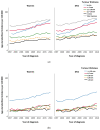Trend Shifts in Age-Specific Incidence for In Situ and Invasive Cutaneous Melanoma in Sweden
- PMID: 34200396
- PMCID: PMC8201382
- DOI: 10.3390/cancers13112838
Trend Shifts in Age-Specific Incidence for In Situ and Invasive Cutaneous Melanoma in Sweden
Abstract
Background: The incidence of invasive cutaneous melanoma (CM) is increasing in Sweden. The aim was to present age- and sex-specific trends of the age-standardised incidence and the average annual percentage change (AAPC) for in situ and invasive CM.
Methods: Joinpoint regression models were used to analyse data from the Swedish Cancer Register and the Swedish Melanoma Registry 1997-2018 (N = 35,350 in situ CM; 59,932 CM).
Results: The AAPC of CM for women was 4.5 (4.1-5.0; p < 0.001) for the period 1997-2018. For men, the APCC was 4.2 (3.0-5.4; p < 0.001), with a significantly higher annual percentage change (APC) for the period 2000-2018 (5.0; 4.6-5.4; p < 0.001) compared to 1997-1999. An increasing annual incidence of CM ≤ 0.6 mm and 0.7 mm Breslow tumour thickness was found for men with a significant incidence shift for the period 2006-2015, respectively. Similarly for women, with a significantly higher APC for CM ≤ 0.6 mm from 2005. The incidence of intermediate thick CM (2.1-4.0 mm) has not increased since 2011. The incidence of CM > 4.0 mm has been increasing among both sexes, with a significantly lower APC among women from 2005.
Conclusions: The incidence of in situ and low-risk CM ≤ 1.0 mm in tumour thickness has been rising among both sexes since the 2000s.
Keywords: age-specific incidence; average annual percentage change; cutaneous melanoma; joinpoint; trend shifts.
Conflict of interest statement
The authors declare no conflict of interest. The funders had no role in the design of the study; in the collection, analyses, or interpretation of data; in the writing of the manuscript, or in the decision to publish the results.
Figures



References
Grants and funding
LinkOut - more resources
Full Text Sources

